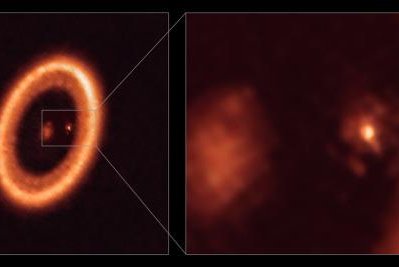
Scientists used the powerful ALMA telescope to identify and measure a circumplanetary disk surrounding an exoplanet located 400 light-years from Earth. Photo by ALMA/ESO/NAOJ/NRAO/Benisty, et al./The Astrophysical Journal
July 22 (UPI) -- Astronomers have for the first time imaged a moon-forming disk around an exoplanet.
Scientists expect the discovery -- made using the Atacama Large Millimetre/submillimeter Array and detailed Thursday in the journal Astrophysical Journal Letters -- to aid the study of planet and moon formation in young solar systems.
"Our work presents a clear detection of a disc in which satellites could be forming," co-author Myriam Benisty, astronomer at the University of Grenoble in France, said in a press release.
"Our ALMA observations were obtained at such exquisite resolution that we could clearly identify that the disc is associated with the planet and we are able to constrain its size for the first time," Benisty said.
A few years ago, astronomers spotted what they thought to be a circumplanetary disc surrounding the exoplanet PDS 70c, one of two Jupiter-like planets orbiting a young star located 400 light-years away in the constellation Centaurus.
At the time, the moon-forming disk was too faint to distinguish from the surrounding gas and dust, but the latest observations by ALMA revealed the disk's dimensions and mass.
Scientists determined the disk is as wide as the distance between Earth and the sun, and also boasts enough material to form three satellites the size of Earth's moon.
"These new observations are also extremely important to prove theories of planet formation that could not be tested until now," said lead study author Jaehan Bae, a researcher from the Earth and Planets Laboratory of the Carnegie Institution for Science.
Scientists knew that a circumplanetary disk can help budding planets capture surrounding planet-forming material and regulate its growth, but until now, they couldn't be certain exactly what this process looked like.
"More than 4,000 exoplanets have been found until now, but all of them were detected in mature systems," said co-author Miriam Keppler, researcher at the Max Planck Institute for Astronomy in Germany.
"PDS 70b and PDS 70c, which form a system reminiscent of the Jupiter-Saturn pair, are the only two exoplanets detected so far that are still in the process of being formed," Keppler said.
PDS 70b and PDS 70c were first located using the European Southern Observatory's Very Large Telescope and later rendered in greater detail using ALMA.
The astronomers hope to gain further insights into planet and satellite formation using ESO's Extremely Large Telescope, which is currently under construction in Chile's Atacama desert.
"The ELT will be key for this research since, with its much higher resolution, we will be able to map the system in great detail," said co-author Richard Teague, a researcher at the Center for Astrophysics at Harvard and the Smithsonian.
No comments:
Post a Comment